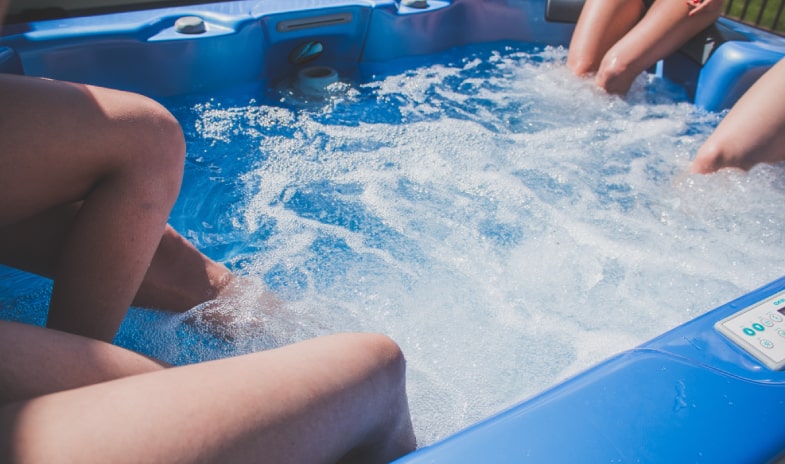Your backyard hot tub is the perfect place to relax… except when it keeps tripping the GFCI circuit breaker! Your hot tub keeps shutting off – what do you do?!? These breaker trips are more than a nuisance; they could be signalling danger. Water and electricity (especially malfunctioning electricity) are a potentially hazardous combination.
If your hot tub breaker won’t reset, check for the 6 issues listed below. Then hire a professional electrician with hot tub experience to resolve the problem.
Do You Need A GFCI Breaker For A Hot Tub?
First things first: Yes, you do need a GFCI (Ground Fault Circuit Interrupter) breaker for your hot tub. Many electrical issues can occur, including dangerous short circuits and outlets being hot to the touch.
Amateurs attempting to set up their hot tub alone often make the mistake of installing a regular 2-pole breaker (which happens to be cheaper). Errors like this are why we don’t recommend doing complex electrical projects yourself.
According to Rule 86-068 of the Canadian Electrical Code, all spas and hot tubs require GFCI breakers for their electrical system. The job of a GFCI is to protect you from electrocution due to ground fault shock while you are in or around the water.
In addition, you’ll need to upgrade your electrical panel, to meet the high demand for your hot tub.
6 Reasons For Repeated Hot Tub GFCI Trips
1. Old GFCI Breaker
Ground fault circuit interrupter breakers are pretty sturdy, but they will eventually wear out, usually after 10-25 years. Lightning strikes or frequent power surges can shorten their lifespan.
When you suspect that your GFCI has tripped because it is too old or has been damaged, test it this way:
- Flip the hot tub circuit breaker to ON.
- If it immediately re-trips, disconnect all appliances connected to that breaker.
- Now flip the GFCI breaker back to ON.
- If it does not trip this time, there is a problem with something you usually plug into the breaker, like a heater, pump, or hot tub component.
- If it does trip again, the breaker itself has gone bad and will have to be replaced by a qualified electrician. Ask whether a power surge caused the problem and if so, inquire about surge protector installation.
2. Faulty Heater
Very often, the source of repeated GFCI breaker trips is the hot tub’s heating element. Disconnect the heater from the electrical system and test the breaker as described above. If the breaker trips only when the heater is connected, you’ve pinpointed the culprit.
The next step is to figure out what caused the problem with your heating element in the first place. Running the heater without enough water in the hot tub, clogs, faulty circulation, and chemical deposits are the most common reasons.
To fix the issue, it might be possible to have only the heating element replaced, depending on your heater type. With some models, though, the entire heater will require replacement.
3. Corroded Components
Rust tends to be a problem in any moist environment. It can corrode your electrical components in a hot tub, including the wiring, connectors, ground wires, or control panel.
WARNING: Always turn off the main electrical supply before inspecting anything to do with electricity. Do not stand in hot tub water or touch anything wet.
Open the electrical box, looking for rust or white powder signs, which indicate corrosion is present. Then check all components; a flashlight can help with this task. Minor corrosion may be removed with a brush. More severe corrosion means that you will probably need to have the wiring redone by a professional electrician.
4. Moisture Within Your Breaker Box
Moisture could be seeping into your hot tub breaker box due to splashing, condensation, rain, or flooding. If so, when the GFCI trips, it is doing its job of keeping you safe from the dangerous mixture of moisture and electricity.
To investigate, turn off the main electrical supply; next, inspect the interior of the breaker box. Try drying any visible moisture with an absorbent cloth, then run a fan, blow dryer, or dehumidifier near the breaker box to dry it more thoroughly. Replace the rubber seal.
Once the breaker has been well dried, there ought to be no further trips. If there are, it could be a signal that you should put up a splash barrier, move the breaker box farther away from your hot tub, or replace the box altogether.
5. Unsecure Electrical Wiring
Another possible cause of frequent breaker trips is unsecure electrical wiring. This can take several forms:
- loosened connections
- sagging wires
- cables touching each other
- wires whose rubber insulation has melted or burnt
- wiring chewed by rodents or other pests
Once again, you will need the services of a certified electrician, who will tighten the connections, separate the cables, or replace the damaged wiring.
6. Flooded Air Blower Or Ozonator
Your hot tub air blower is a fun hot tub accessory, while the ozonator is necessary for tub maintenance and hygiene. However, both might occasionally flood from backflow when filling your hot tub too full or one of the valves has failed. The solution is to empty some of the excess water and, if necessary, to have the faulty valve replaced.
Sun Electrical Will Make Your Hot Tub Safe And Fun
We are professional electricians in the Calgary area who have solid experience working with hot tub problem solving. Contact us for reliable hot tub repair and installation. We’ll do it right, to make your hot tub as safe as it is fun!





